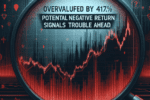New York, USA – The second quarter of trading in the financial markets saw a strong performance from the S&P 500 Index, with a notable increase driven primarily by the information technology (‘IT’) sector. However, this surge in performance was heavily concentrated in just three stocks – Apple, Microsoft, and Nvidia. These industry giants accounted for over 85% of all gains during this period, highlighting a significant level of market concentration that could have profound implications for portfolio construction strategies, especially for those with broadly diversified, core portfolios.
The rise of technology companies within the S&P 500 has been a notable trend over the past decade, with the IT sector’s weight increasing from 18% to over 40% of the index. This growth in market value for technology firms has led to some concerns about the lack of diversification within the benchmark index, raising questions about whether the S&P 500 still qualifies as a diversified benchmark given the heavy weighting of one sector.
The issue of market concentration is further exacerbated at the single-stock level, with Apple, Microsoft, and Nvidia collectively representing over 20% of the S&P 500, equivalent to the bottom 362 stocks. This level of concentration raises concerns about the overall health and stability of the market, particularly in the event of a downturn. The prevalence of passive investing and indexation has further compounded these risks, as the flow of passive money into the market can exacerbate movements in these heavily weighted stocks.
The rapid growth of passive investing has also led to heightened focus on relative performance, with investors closely comparing their returns to benchmark indices like the S&P 500. This emphasis on benchmark performance has shifted the investment landscape, raising questions about the true diversification and risk exposure of portfolios that closely track these indices. In light of these trends, many asset managers are reevaluating their investment strategies to ensure that they are prudently managing their clients’ assets.
Despite the market’s current concentration in certain sectors, some investment managers, like those at ClearBridge Dividend Strategy, continue to prioritize diversification and prudent investment practices. By focusing on bottom-up analysis and selecting high-quality, undervalued companies across various sectors, these managers aim to deliver consistent returns while mitigating risks associated with concentrated portfolios.
Looking ahead, uncertainties in the global economy and financial markets continue to pose challenges for investors. From geopolitical tensions to fiscal policies and interest rate expectations, the investment landscape remains complex and unpredictable. As such, maintaining a cautious and prudent approach to portfolio management is essential to navigate these uncertain times and safeguard investors’ assets in the face of potential market volatility.










